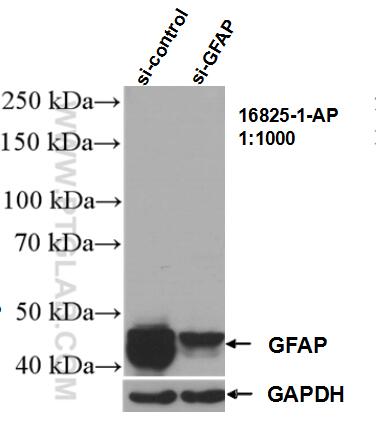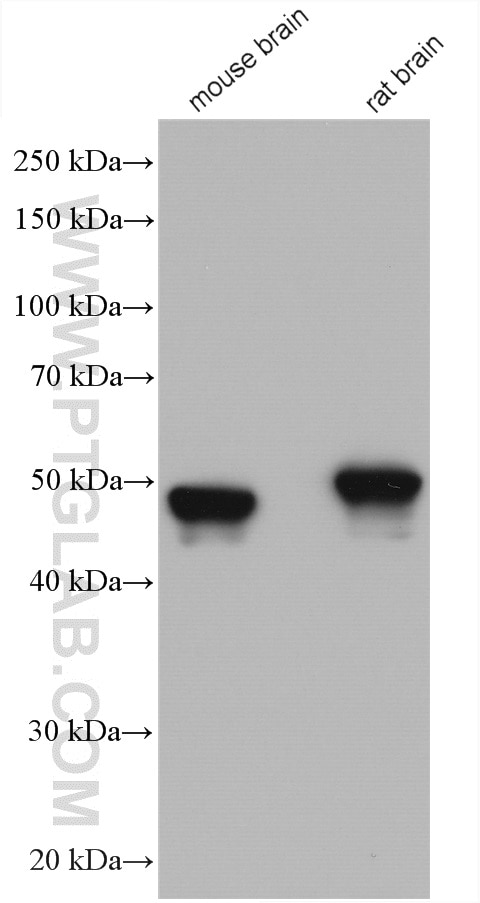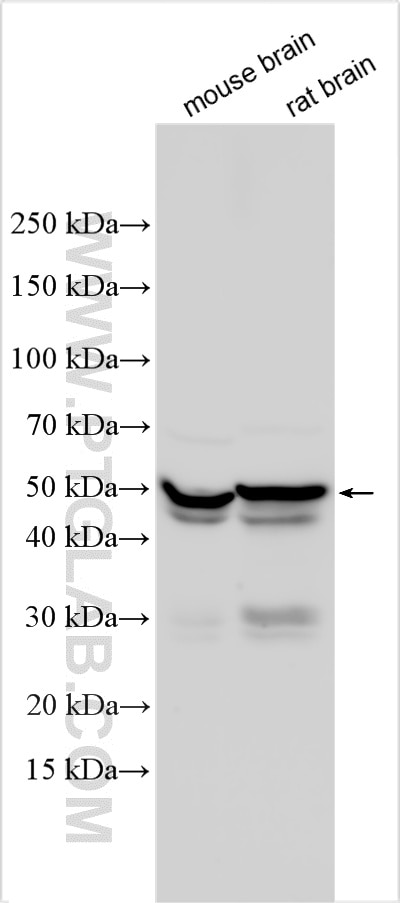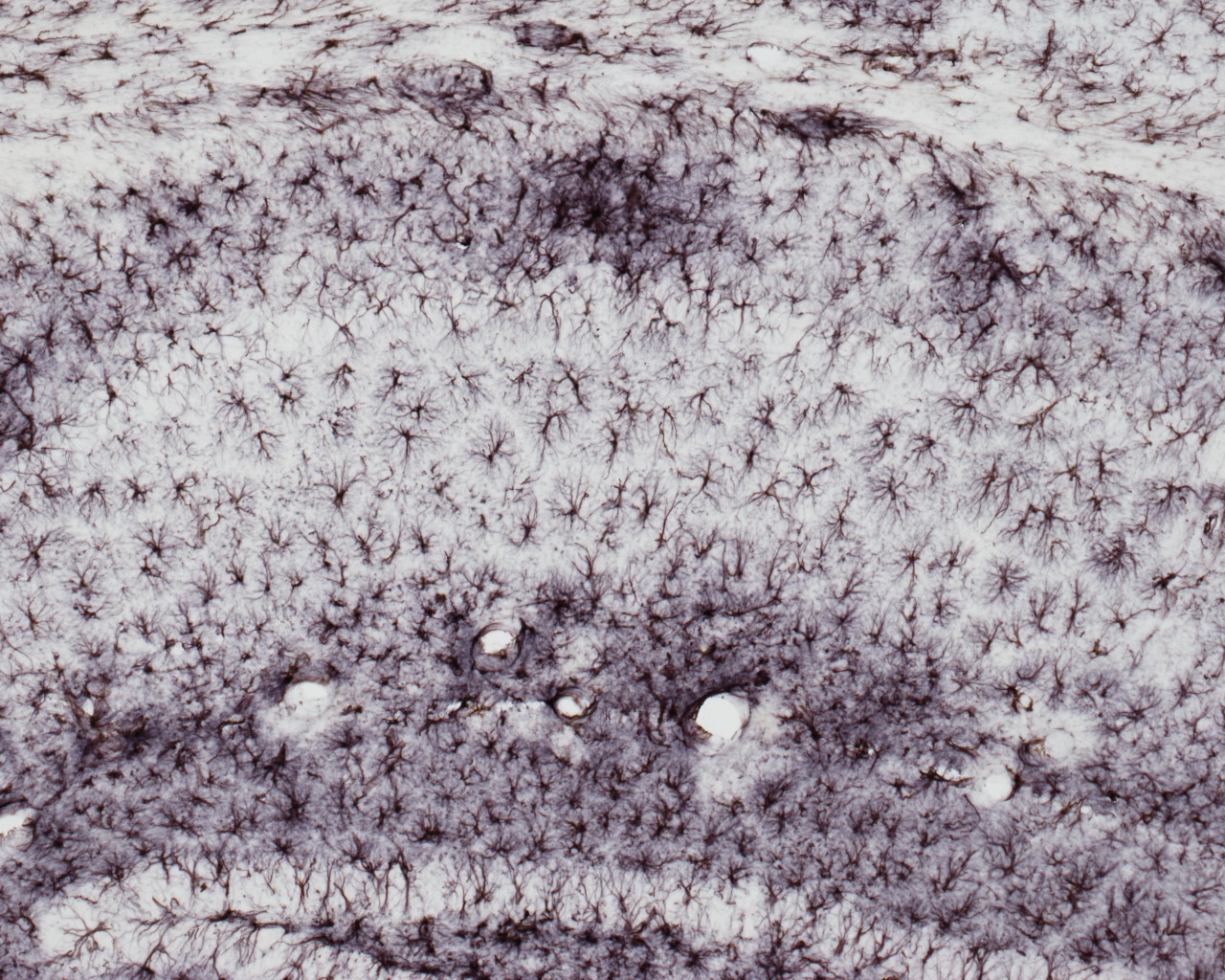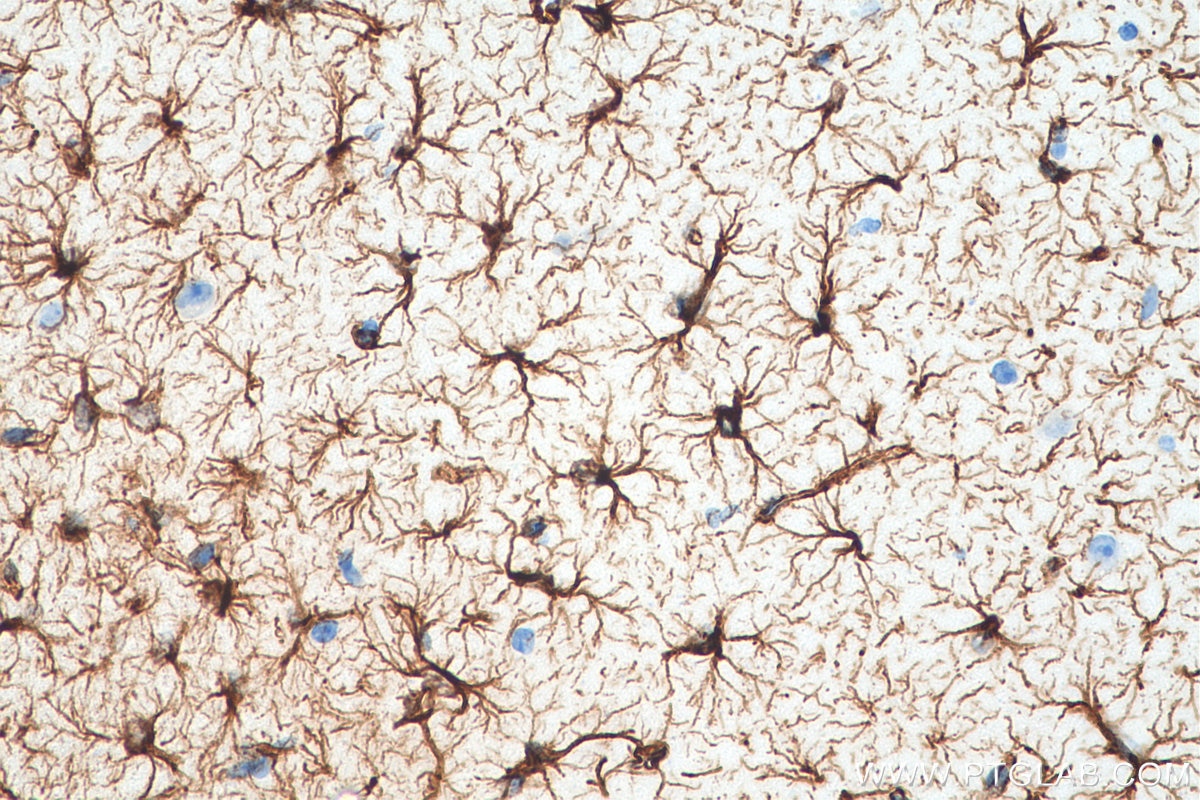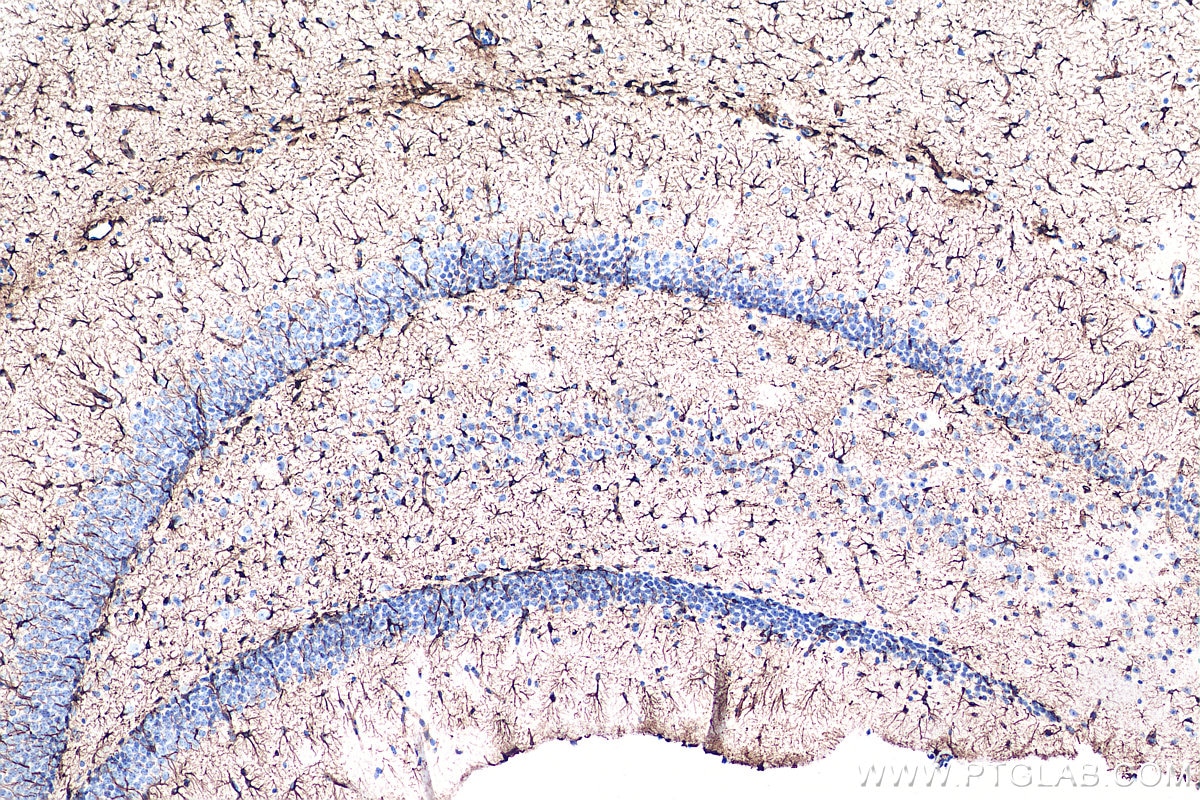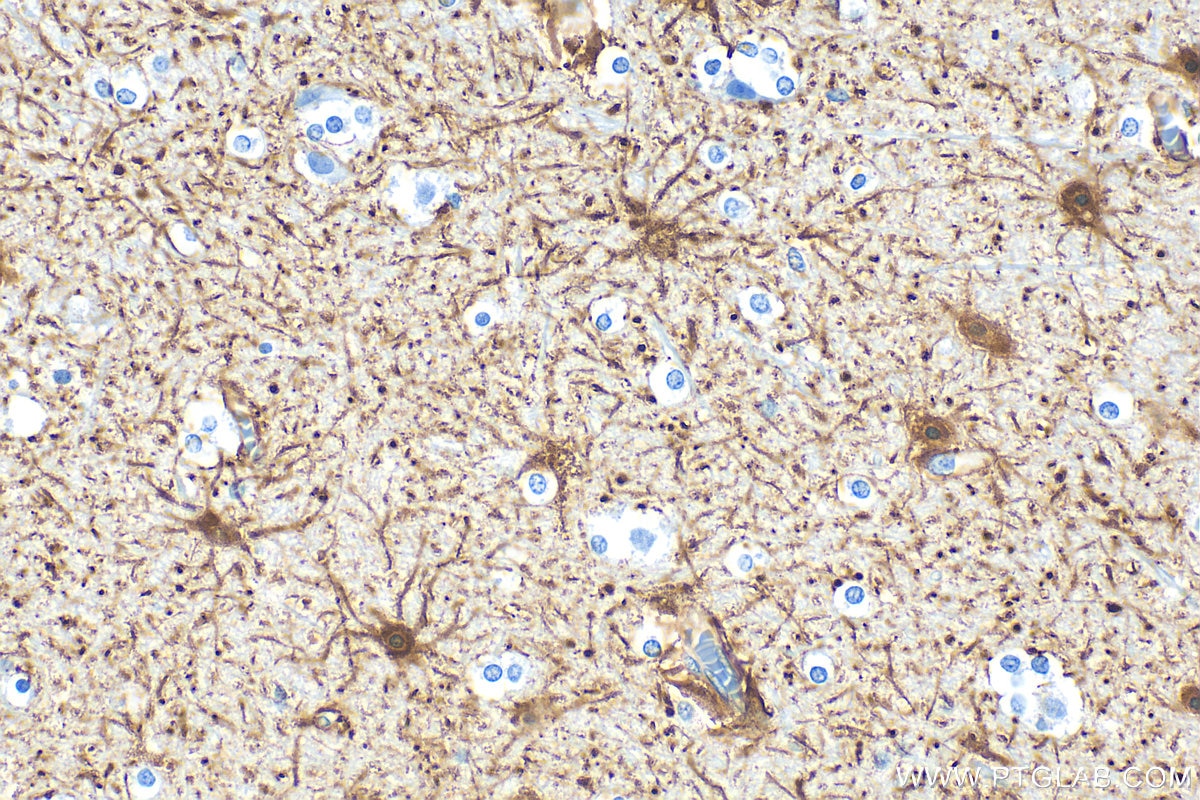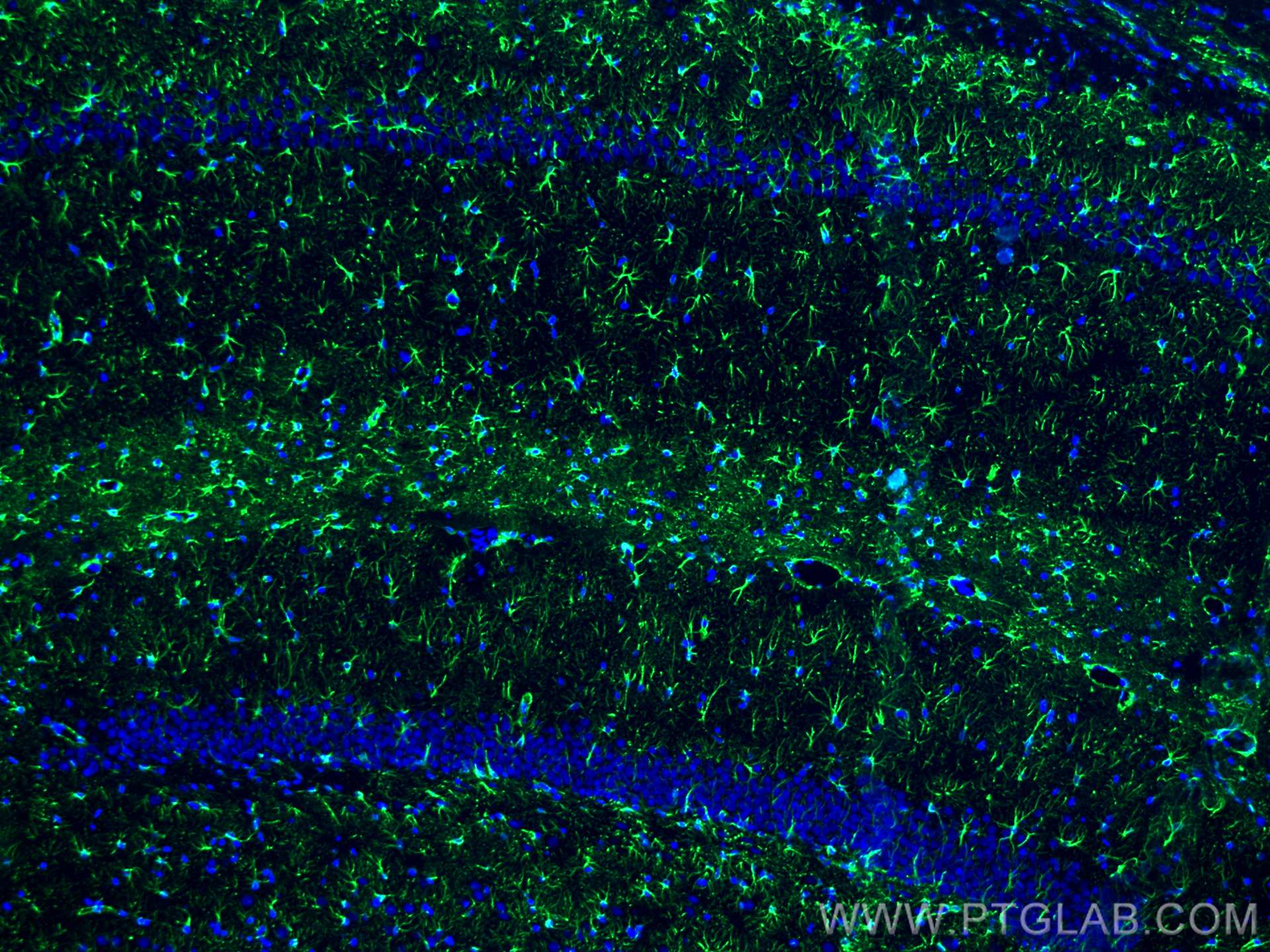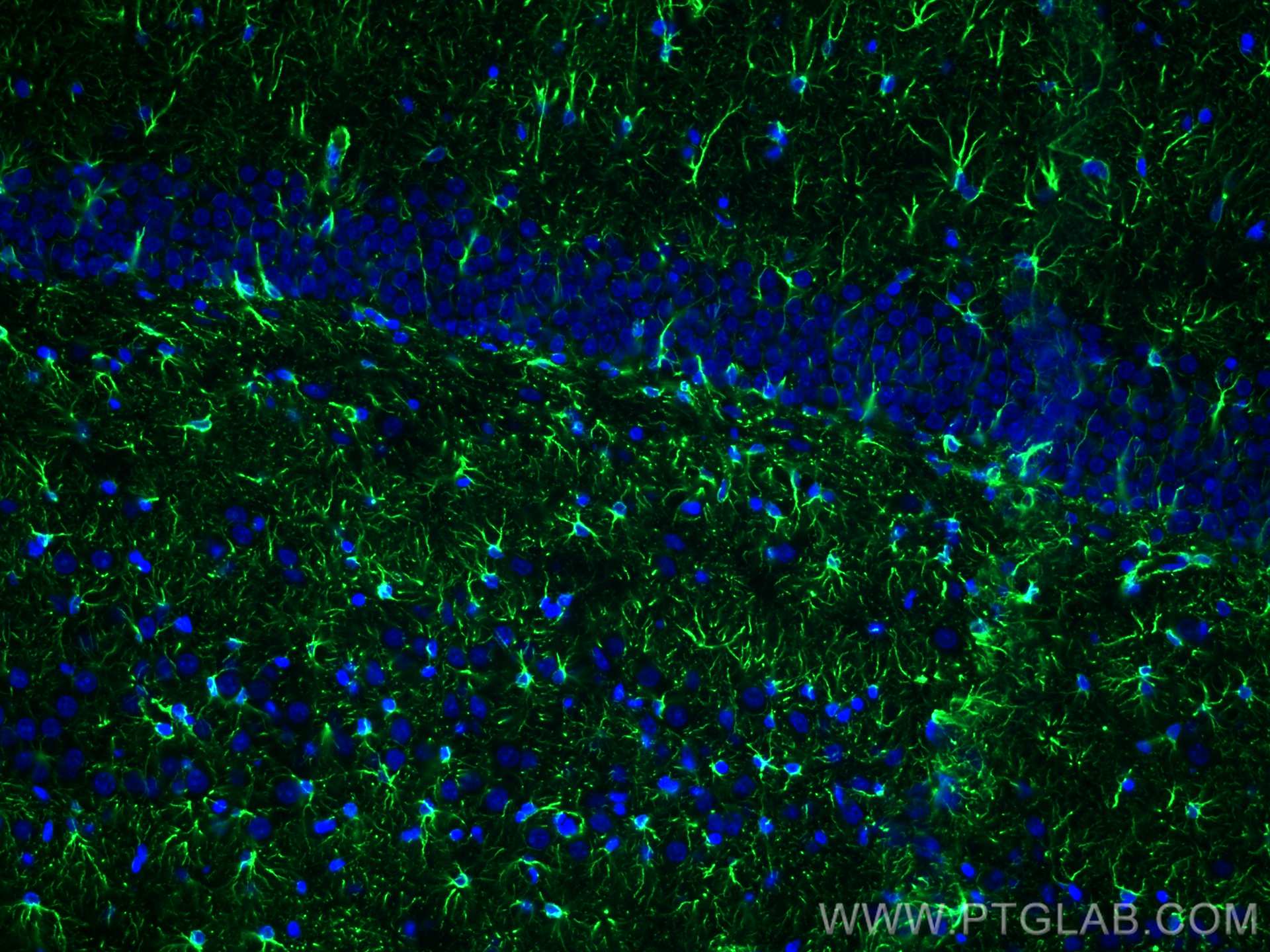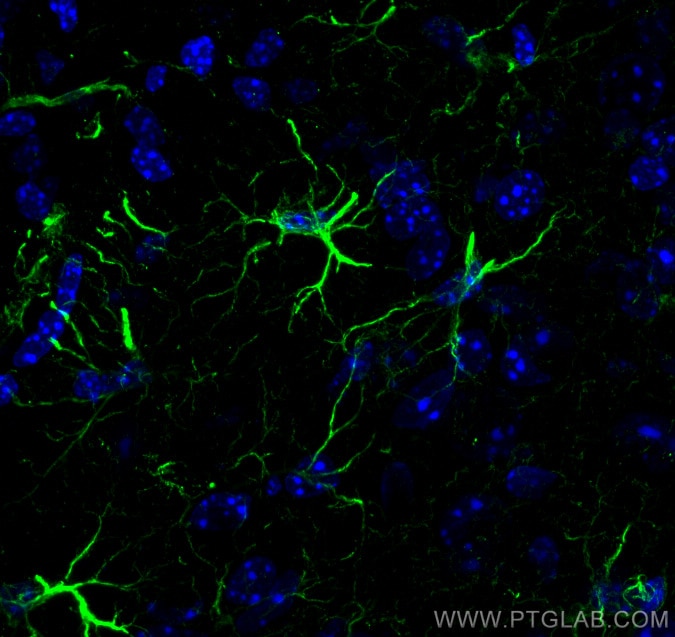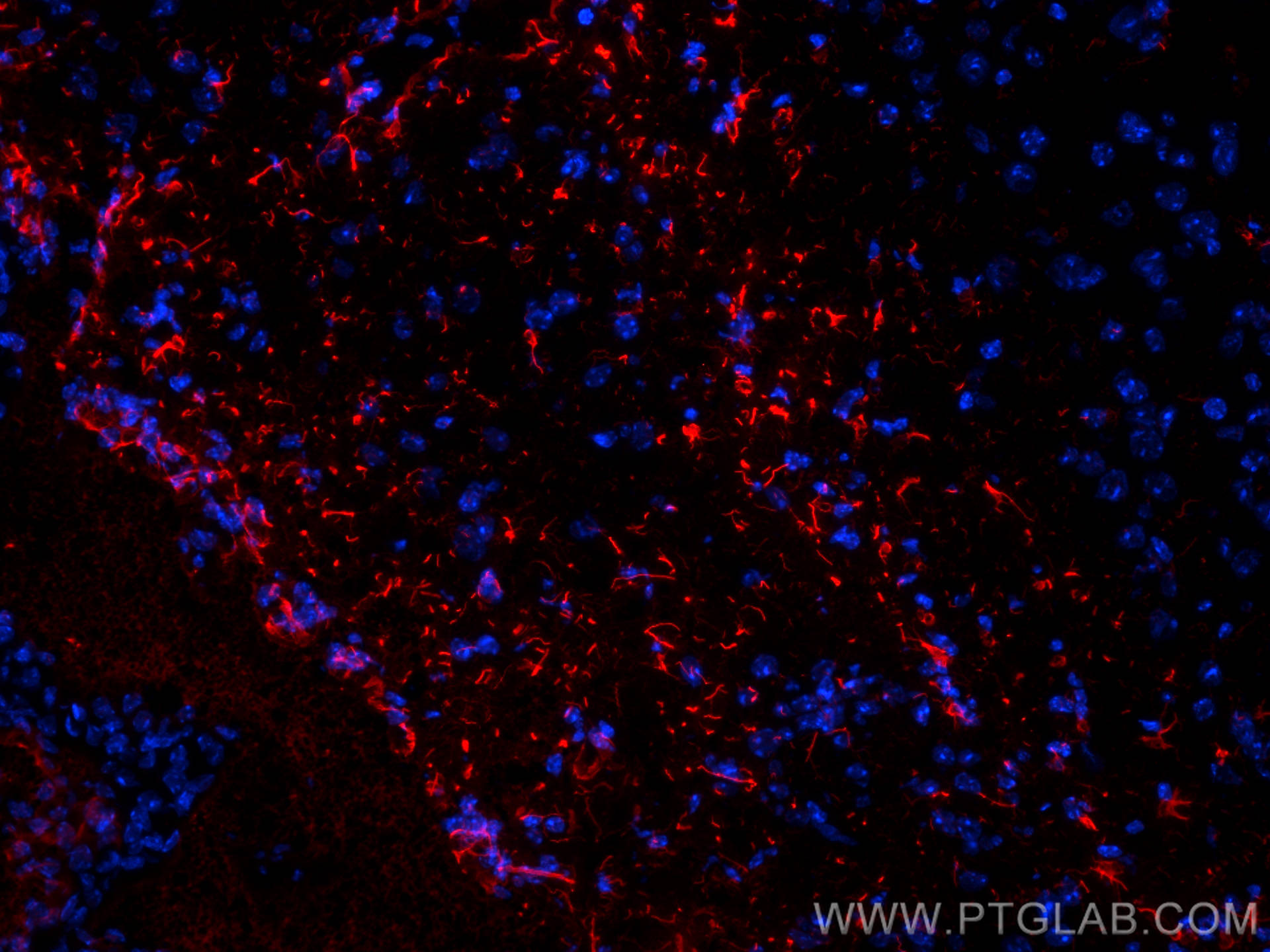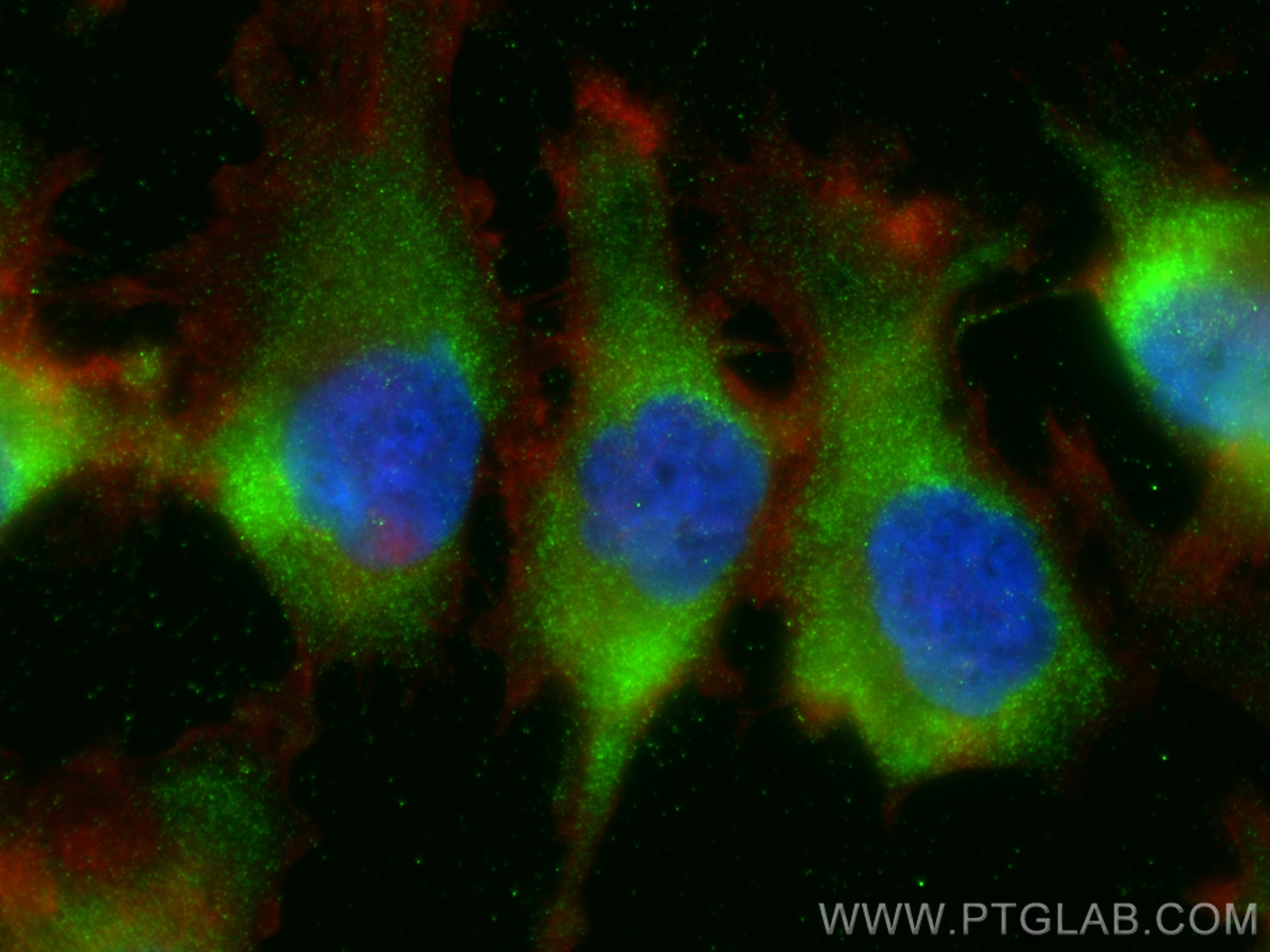Tested Applications
| Positive WB detected in | mouse brain tissue, U-251 cells, rat brain tissue |
| Positive IHC detected in | mouse brain tissue, Alzheimer mouse, human brain tissue Note: suggested antigen retrieval with TE buffer pH 9.0; (*) Alternatively, antigen retrieval may be performed with citrate buffer pH 6.0 |
| Positive IF-P detected in | rat brain tissue, mouse brain tissue |
| Positive IF-Fro detected in | mouse brain tissue |
| Positive IF/ICC detected in | A172 cells |
Recommended dilution
| Application | Dilution |
|---|---|
| Western Blot (WB) | WB : 1:20000-1:100000 |
| Immunohistochemistry (IHC) | IHC : 1:2500-1:10000 |
| Immunofluorescence (IF)-P | IF-P : 1:50-1:500 |
| Immunofluorescence (IF)-FRO | IF-FRO : 1:500-1:2000 |
| Immunofluorescence (IF)/ICC | IF/ICC : 1:50-1:500 |
| It is recommended that this reagent should be titrated in each testing system to obtain optimal results. | |
| Sample-dependent, Check data in validation data gallery. | |
Published Applications
| WB | See 206 publications below |
| IHC | See 110 publications below |
| IF | See 480 publications below |
Product Information
16825-1-AP targets GFAP in WB, IHC, IF/ICC, IF-P, IF-Fro, ELISA applications and shows reactivity with human, mouse, rat samples.
| Tested Reactivity | human, mouse, rat |
| Cited Reactivity | human, mouse, rat, pig, rabbit, monkey, zebrafish, hamster, goat, duck |
| Host / Isotype | Rabbit / IgG |
| Class | Polyclonal |
| Type | Antibody |
| Immunogen |
CatNo: Ag10423 Product name: Recombinant human GFAP protein Source: e coli.-derived, PGEX-4T Tag: GST Domain: 83-432 aa of BC013596 Sequence: YIEKVRFLEQQNKALAAELNQLRAKEPTKLADVYQAELRELRLRLDQLTANSARLEVERDNLAQDLATVRQKLQDETNLRLEAENNLAAYRQEADEATLARLDLERKIESLEEEIRFLRKIHEEEVRELQEQLARQQVHVELDVAKPDLTAALKEIRTQYEAMASSNMHEAEEWYRSKFADLTDAAARNAELLRQAKHEANDYRRQLQSLTCDLESLRGTNESLERQMREQEERHVREAASYQEALARLEEEGQSLKDEMARHLQEYQDLLNVKLALDIEIATYRKLLEGEENRITIPVQTFSNLQIRETSLDTKSVSEGHLKRNIVVKTVEMRDGEVIKESKQEHKDVM Predict reactive species |
| Full Name | glial fibrillary acidic protein |
| Calculated Molecular Weight | 432 aa, 50 kDa |
| Observed Molecular Weight | 45-50 kDa |
| GenBank Accession Number | BC013596 |
| Gene Symbol | GFAP |
| Gene ID (NCBI) | 2670 |
| RRID | AB_2109646 |
| Conjugate | Unconjugated |
| Form | Liquid |
| Purification Method | Antigen affinity purification |
| UNIPROT ID | P14136 |
| Storage Buffer | PBS with 0.02% sodium azide and 50% glycerol, pH 7.3. |
| Storage Conditions | Store at -20°C. Stable for one year after shipment. Aliquoting is unnecessary for -20oC storage. 20ul sizes contain 0.1% BSA. |
Background Information
Function
GFAP (Glial fibrillary acidic protein) is a type III intermediate filament (IF) protein specific to the central nervous system (CNS). GFAP is one of the main components of the intermediate filament network in astrocytes and has been proposed as playing a role in cell migration, cell motility, maintaining mechanical strength, and in mitosis.Tissue specificity
GFAP is expressed in central nervous system cells, predominantly in astrocytes. GFAP is commonly used as an astrocyte marker. However, GFAP is also present in peripheral glia and in non-CNS cells, including fibroblasts, chondrocytes, lymphocytes, and liver stellate cells (PMID: 21219963).Involvement in disease
- Mutations in GFAP lead to Alexander disease (OMIM: 203450), an autosomal dominant CNS disorder. The mutations present in affected individuals are thought to be gain-of-function.
- Upregulation of GFAP is a hallmark of reactive astrocytes, in which GFAP is present in hypertrophic cellular processes. Reactive astrogliosis is present in many neurological disorders, such as stroke, various neurodegenerative diseases (including Alzheimer's and Parkinson's disease), and neurotrauma.
Isoforms
Astrocytes express 10 different isoforms of GFAP that differ in the rod and tail domains (PMID: 25726916), which means that they differ in molecular size. Isoform expression varies during the development and across different subtypes of astrocytes. Not all isoforms are upregulated in reactive astrocytes.Post-translational modifications
Intermediate filament proteins are regulated by phosphorylation. Six phosphorylation sites have been identified in GFAP protein, at least some of which are reported to control filament assembly (PMID: 21219963).Cellular localization
GFAP localizes to intermediate filaments and stains well in astrocyte cellular processes.Protocols
| Product Specific Protocols | |
|---|---|
| IF protocol for GFAP antibody 16825-1-AP | Download protocol |
| IHC protocol for GFAP antibody 16825-1-AP | Download protocol |
| WB protocol for GFAP antibody 16825-1-AP | Download protocol |
| Standard Protocols | |
|---|---|
| Click here to view our Standard Protocols |
Publications
| Species | Application | Title |
|---|---|---|
Cell Metab Acetate enables metabolic fitness and cognitive performance during sleep disruption | ||
Nat Metab Mitochondrial fission drives neuronal metabolic burden to promote stress susceptibility in male mice | ||
Nat Cell Biol RNA-binding proteins mediate the maturation of chromatin topology during differentiation | ||
Nat Commun Bicarbonate signalling via G protein-coupled receptor regulates ischaemia-reperfusion injury |
Reviews
The reviews below have been submitted by verified Proteintech customers who received an incentive for providing their feedback.
FH Monica (Verified Customer) (11-14-2025) | Good antibody for GFAP on mouse retina (paraffin embedded) . Antigen retrieval was required previous to staining. Worked well and give clean signal.
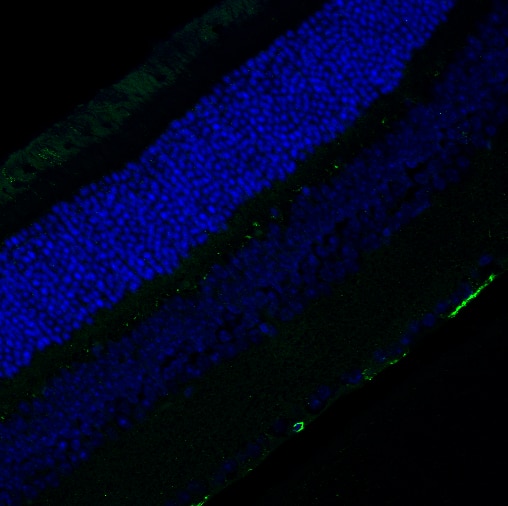 |
FH Gabriele (Verified Customer) (09-01-2025) | It works very well for IF on hiPSC-derived cortical brain organoid sections (GFAP in yellow and nuclei in blue). The dilution can certainly be increased.
 |
FH Rashmi (Verified Customer) (09-25-2024) | used for western blot
|
FH Maria-Luisa (Verified Customer) (08-22-2024) | Antigen retrieval with citrate buffer prior to IF staining
|
FH Vikas (Verified Customer) (07-11-2024) | Used for IF, Worked very well, Highly recommended.
|
FH manohar (Verified Customer) (03-06-2024) |
|
FH Badrieh (Verified Customer) (08-02-2022) | this Antibody worked really great with different Recombinant GFAP proteins in ELISA.
|
FH Silvia (Verified Customer) (09-30-2021) | Immunofluorescence works well on U251-MG human astrocytoma cell line
|
FH Azita (Verified Customer) (05-31-2021) | The human primary cortical cells (DIV28) were subjected to ICC using GFAP antibody (at 1/500 dilution) overnight at 4°C.
|
FH Diane (Verified Customer) (01-03-2020) | I have used this antibody successfully for formalin-fixed paraffin-embedded brain tissues in humans, mouse and rat. I am impressed that there is no non-specific background staining regardless of species. We have used the antibody in a double-staining technique and were able to achieve crisp diagnostic staining for images. The astrocytes were stained using alkaline phosphatase Permanent Red. Antigen retrieval was performed using proteinase K.
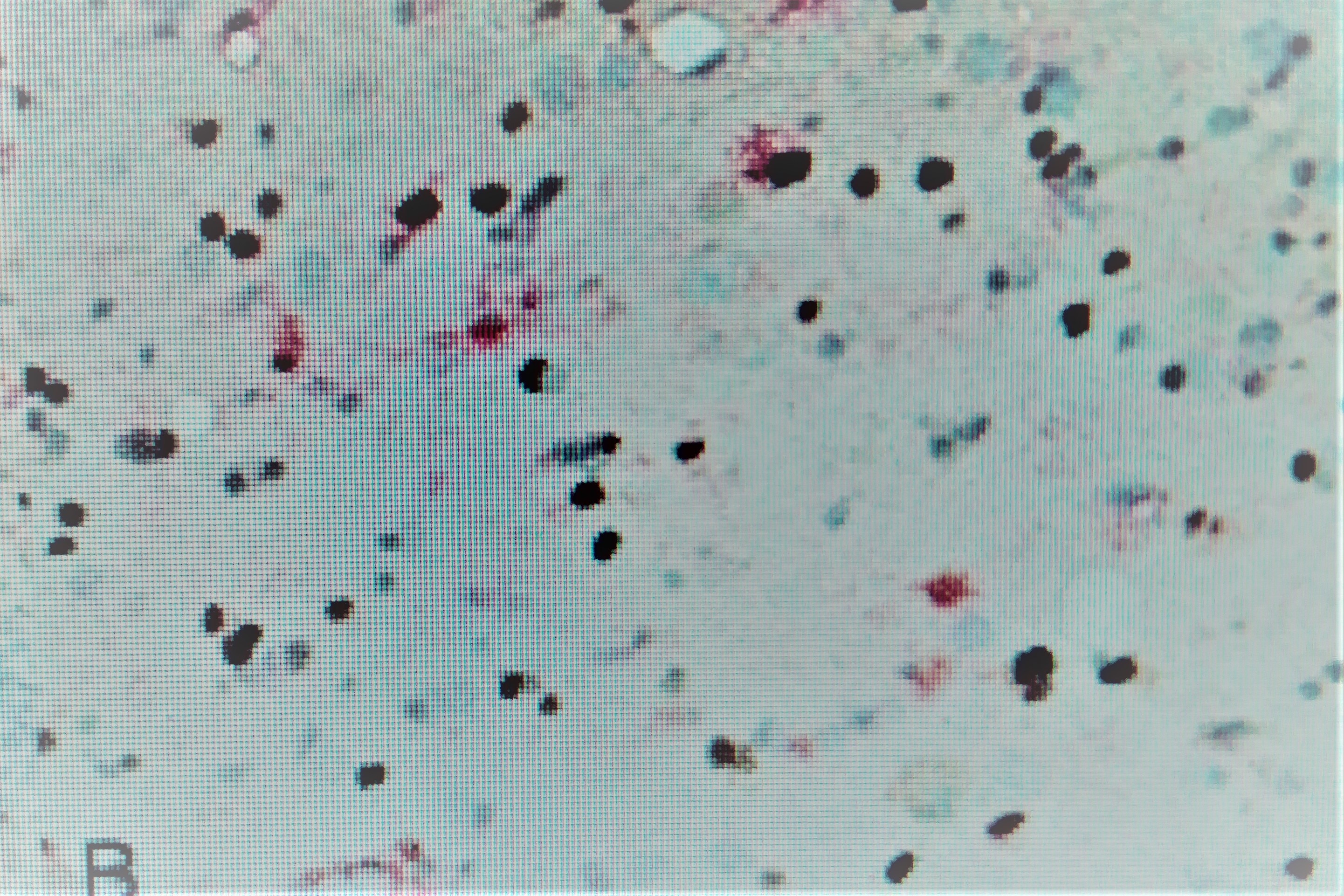 |
FH Tanusree (Verified Customer) (12-03-2019) | This antibody works good immuno-fluorescence and western blotting analysis using mouse brain tissues.
|
FH Ryan (Verified Customer) (02-14-2018) | NaCit antigen retrieval ph=6
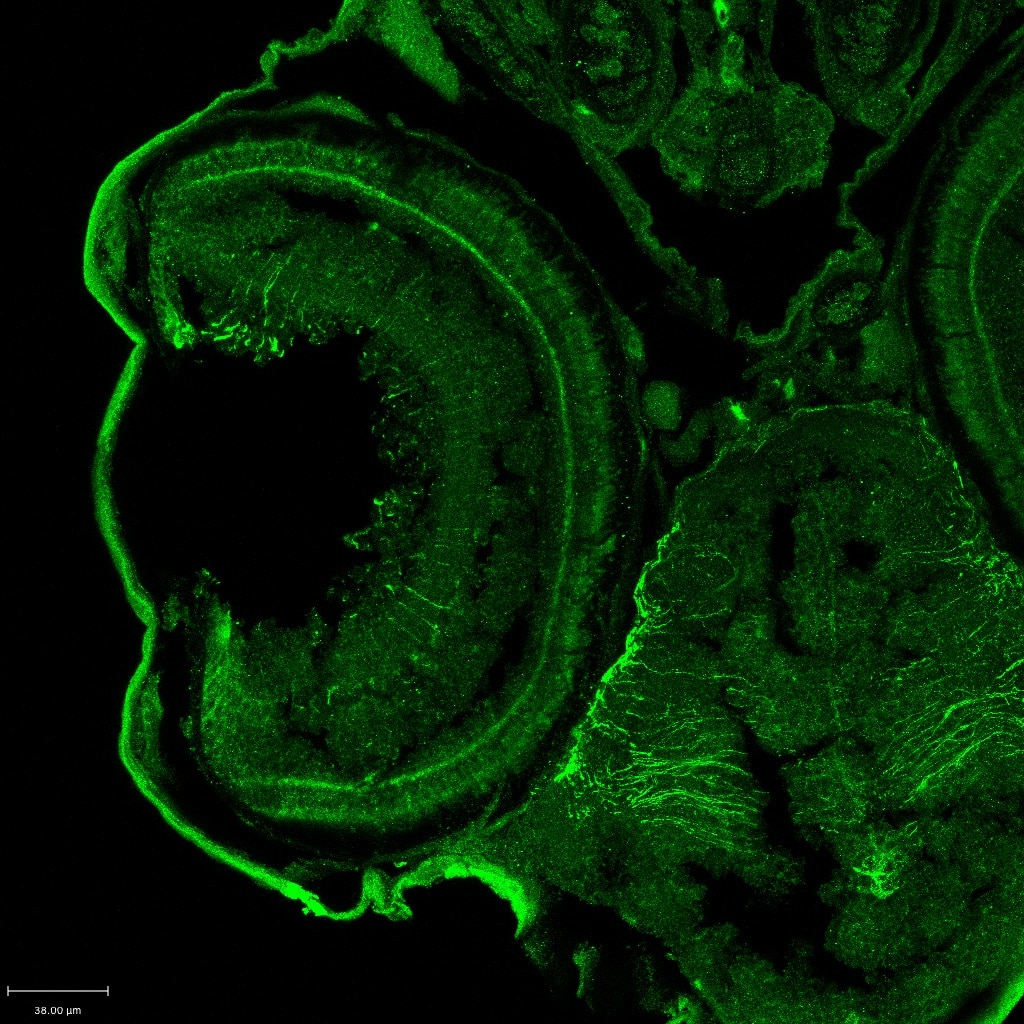 |

